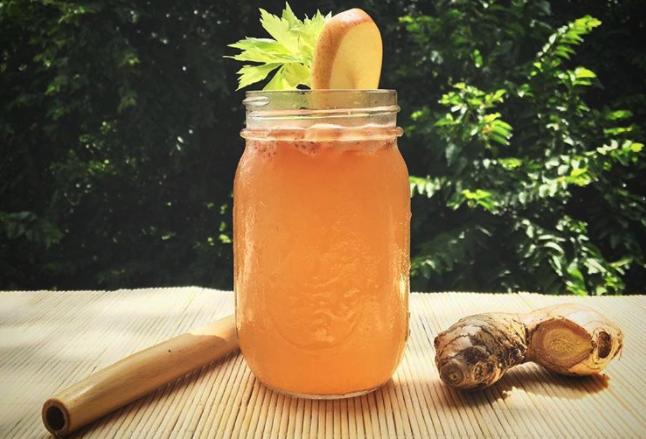These Are The World’s Funkiest Fermented Drinks

@gingerroot_zicatela
If you haven’t hopped on the kombucha train just yet, there are all kinds of other fermented drinks out there that you can get your hands on. Fermented foods, also known as probiotic foods, replenish your body with good bacteria that are helpful for your gut health and gastrointestinal system as a whole, which is important for your overall well-being. Check out the world’s funkiest fermented drinks below and see which ones you might want to give a try.
Dark Tea
This class of tea, called dark tea or Hei Cha, goes through a fermentation process for anywhere from several months to a couple of years. (Its name in Chinese means anything that goes through a secondary fermentation process.) In China, dark tea also goes by the name of Border-Sale Tea since it’s literally sold on the borders of the country. It’s usually compressed into brick form so can you just cut off pieces as you need them to steep. The tea is bold tasting and meant to be consumed after meals as a digestive.
Kefir
Tart and refreshing, kefir is like drinkable yogurt but with additional, beneficial yeast and friendly probiotic bacteria. Kefir is loaded with vitamins and minerals, and it contains complete proteins that are easily digestible. It can be made from any type of milk — cow, goat, sheep, coconut, rice, you name it — but cow milk is used most often.
No matter what brand of kefir you buy, you’re getting milk, kefir grains and time in a bottle. The probiotics in kefir support your immune system and help with weight management. It’s pretty much a tangy milkshake with a slightly fizzy feel to it.
Kvass
During the Soviet era, while American kids were excited about soda, Russian kids were lining up for the kvass truck. Kvass is an ancient fermented bread drink, usually made from stale, dark rye bread (which is known as black bread in Russia). The drink is brown and bubbly with a similar taste to beer, but the alcohol content is so low that’s it’s considered a non-alcoholic beverage.
Commercial kvass is more like a malted soda. The bread is soaked in water and then other ingredients like raisins, honey and mint are added. The whole batch is fermented for a few days, which creates a natural carbonation and a specific sour flavor. Sour foods are at the core of Russian cuisine, kvass fits right in. The fermentation also helps to preserve the vitamin-packed fruits and vegetables during cold winters. Kvass is rich in B vitamins and it’s looked to as a possible hangover helper.
Basi
This fermented sugar cane drink of the Philippines is made by crushing sugar cane and extracting the juice. The juice is boiled and mixed with sumac leaves and different kinds of bark in large vats, and then stored in earthenware jars. After the juice cools, different flavorings are added like duhat (java plum) bark or ground rice. The leaves have high levels of wine yeast on them, which causes the sugarcane juice to ferment. Some of the best basi are aged up to 10 years. The taste is sweet and sour with a little bitterness from the bark. The alcohol content ranges from 10 to 16 percent.
Toddy
Palm wine, or toddy, is made from the sap of different palm trees. In South Asia, they prefer coconut palms or palmyra palms. In India, toddy is served as either a sweet, non-alcoholic beverage or as a sour drink made from fermented sap that contains alcohol. Toddy is slightly less alcoholic than wine, and when it’s made from palm, it’s also considered a sedative and mild laxative.
Fresh toddy is light in color and has the consistency of water, and fermented toddy typically takes on a dark shade of off-white. The taste is mildly sweet, but the longer it ferments, the more of a strong, sour and acidic taste it develops. Fun fact: a “palm wine tapper” has to climb to the top of a tree with a slashing sword, knife and gallon container to create a hole in the tree so sap can drip out.
Ibwatu
Zambia, a landlocked country in Southern Africa, is the origin of this popular fermented drink. Zambians call it “sweet beer.” Ibwatu is made from pounded roots that are mixed with bits of maize. You can drink it right after it’s made or let it ferment for a few days.
Ibwatu is considered a natural energy drink in Africa. Some regions make the drink with sorghum, millet, sweet potato or Irish potato. The color depends on the roots used to make the drink. You can make your own with Ibwatu roots, cornmeal, sugar and filtered water. The drink should stand for a day before you drink it cold.
Kombucha
For thousands of years, people have been drinking this fermented probiotic tea. It has roots in China during the Tsin Dynasty where it was thought to be “The Tea of Immortality.” Kombucha is made from tea, sugar, a SCOBY (which stands for symbiotic colony of bacteria and yeast) and a starter from a previous batch of kombucha. The good bacteria and yeast work together to ferment.
The final product is fizzy and naturally carbonated, plus the health benefits are off the charts. There’s a vinegary taste to kombucha and it comes in all different flavor combinations. The best way to describe most kombucha is an amber-colored drink that smells like a combination of tart apples, ginger and vinegar. It’ll probably take you a few drinks to get used to it, but it can be addicting after a while.











